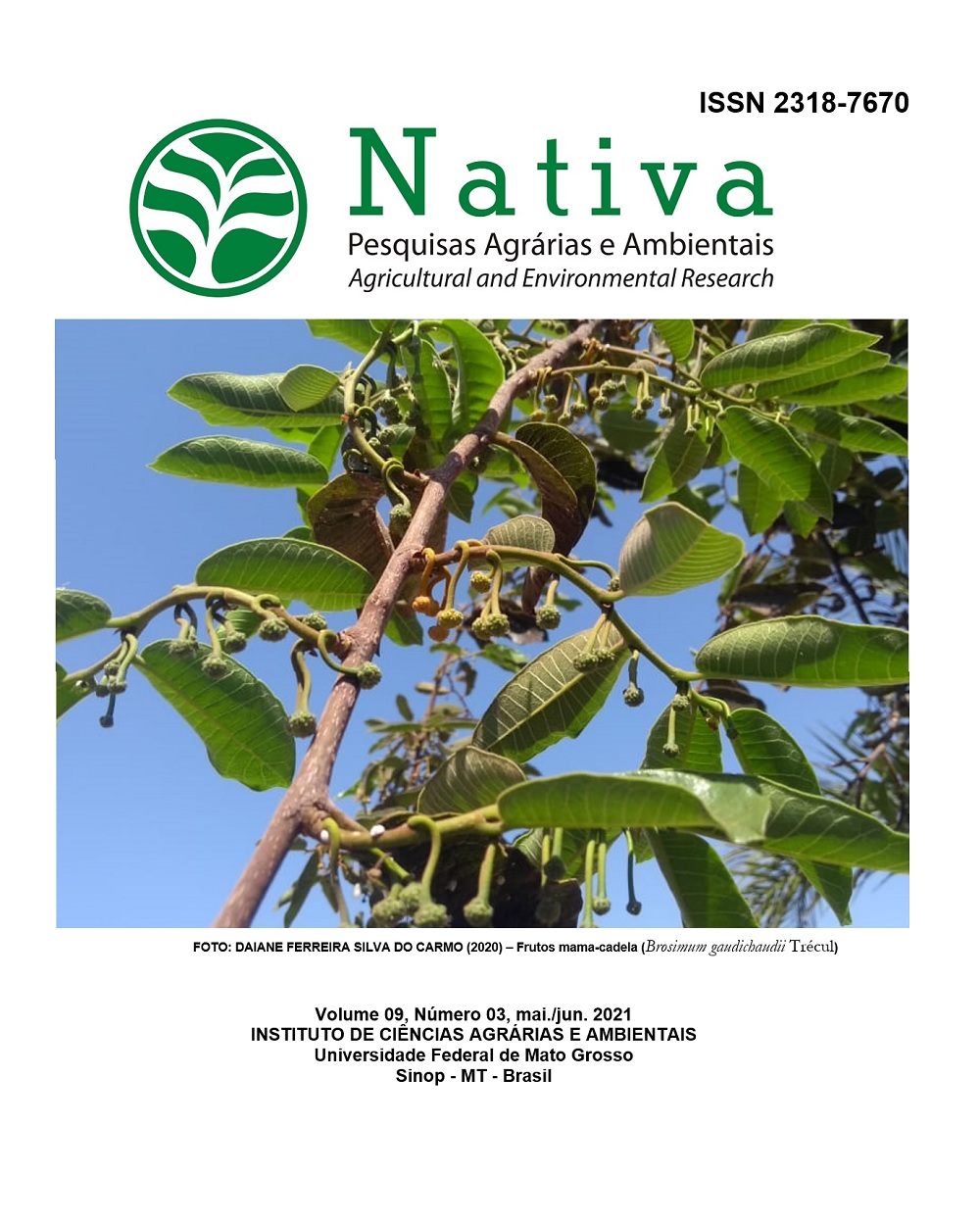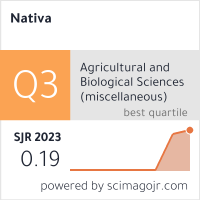Colletotrichum spp: SENSIBILIDADE À FUNGICIDAS E REAÇÃO À CULTIVARES DE SOJA
DOI:
https://doi.org/10.31413/nativa.v9i3.10432Palavras-chave:
Glycine max; tombamento; incidência; severidade; antracnose.Resumo
Antracnose é uma das doenças economicamente mais importantes da soja e de difícil controle no Mato Grosso, causando perdas significativas de produtividade. Objetivo foi verificar a sensibilidade de fungicidas e reação de cultivares de soja a 30 isolados de Colletotrichum. A ação de sete fungicidas (azoxistrobina + ciproconazol, piraclostrobina + epoxiconazol, trifloxistrobina + protioconazol, piraclostrobina, carbendazim, fluxpiroxada + piraclostrobina e azoxistrobina) foi avaliada medindo o crescimento micelial in vitro. Todos os fungicidas afetaram o crescimento micelial, mas piraclostrobina + epoxiconazol e piraclostrobina foram os mais eficientes. Além disso, 6 cultivares foram inoculadas com 27 isolados para análise de tombamento pré e pós-emergência, incidência e severidade da doença. Os dados de incidência e severidade foram submetidos à fórmula da Área Abaixo da Curva de Progresso da Doença. Interação significativa foi observada entre isolados e cultivares em todas as variáveis. Os isolados IT-4, IT-6, LU-3, MT-1, NU-5, PN-1, QU-2, SO-6, SO-11 e VR-1 apresentaram maior tombamento e AACPD. Exceto QU-2 todos os isolados apresentam conídios falcados. As cultivares 8866, 1179 e 9144 apresentaram menor incidência e severidade da doença.
Palavras-chave: Glycine max; tombamento; incidência; severidade; antracnose.
Colletotrichum spp.: Sensibility to fungicides and reaction of commercial germoplasm of soybean
ABSTRACT: Anthracnose is one of the most economically important disease of soybean and difficult to control at Mato Grosso State, causing significant yield losses. Objective was to verify the fungicides sensitivity and soybean cultivars reaction to 30 isolates of Colletotrichum. The action of seven fungicides (azoxystrobin+cyproconazole, pyraclostrobin+epoxiconazole, trifloxystrobin+protioconazole, pyraclostrobin, carbendazim, fluxpyroxade+pyraclostrobin and azoxystrobin) was evaluated measuring in vitro mycelial growth. All fungicides affected the mycelial growth development, but pyraclostrobin + epoxiconazole and pyraclostrobin were the most efficient. Besides, 6 soybean cultivars were inoculated with 27 isolates to analyze pre and post-emergence damping-off, disease incidence and severity. Incidence and severity data were submitted to the formula Area Under the Disease Progress Curve. Significant interaction was observed between isolates and cultivars in all variables. Isolates IT-4, IT-6, LU-3, MT-1, NU-5, PN-1, QU-2, SO-6, SO-11 and VR-1 showed higher damping-off and AUDPC. Excepting the QU-2, all isolates have falcate conidia. Cultivars 8866, 1179 and 9144 presented the lowest disease severity and incidence.
Keywords: Glycine max; damping-off; incidence; severity; anthracnose.
Referências
BARBIERI, M. C. G.; CIAMPI-GUILLARDI, M.; MORAES, S. R. G.; BONALDO, S. M.; ROGERIO, F.; LINHARES, R. R.; MASSOLA JUNIOR, N. S. First report of Colletotrichum cliviae causing anthracnose on soybean in Brazil. Plant Disease, Saint Paul, v. 101, n. 9, p. 1677, 2017. DOI: https://doi.org/10.1094/PDIS-07-16-0963-PDN
BEGUM, M. M.; SARIAH, M.; PUTEH, A. B.; ZAINAL-ABIDIN, M. A. Pathogenicity of Colletotrichum truncatum and its influence on soybean seed quality. International Journal of Agriculture and Biology, Punjab, v. 10, n .4, p. 393-398, 2008.
CAMPBELL, C. L.; MADDEN, L. V. Introduction to plant disease epidemiology. New York: J. Wiley & Sons, 1990. 532p.
CHEN, L. S.; CHU, C.; LIU, C. D.; CHEN, R. S.; TSAY, J. G. PCR-based Detection and differentiation of anthracnose pathogens, Colletotrichum gloeosporioides and C. truncatum, from vegetable soybean in Taiwan. Journal of Phytopathology, Berlin, v. 154, p. 654–662, 2006. DOI: https://doi.org/10.1111/j.1439-0434.2006.01163.x
CONAB_Companhia Nacional de Abastecimento. Acompanhamento da safra brasileira de grãos, v. 7, n. 6, p. 31, 2020. Disponível em: https://www.conab.gov.br/info-agro/safras/graos. Acesso em: 20 mar 2020.
COSTA, I. F. D.; BALARDIN, R. S.; MEDEIROS, L. A.; BAYER, T. M. Resistencia de seis cultivares de soja ao Colletotrichum truncatum (Schwein) em dois estádios fenológicos. Ciência Rural, Santa Maria, v. 36, n. 6, p. 1684-1688, 2006.
COSTA, I. F. D.; BALARDIN, R. S.; MEDEIROS, L. A. M.; LENZ, G.; GULART, C.A.; ZEMOLIN, C. R.; SILVA, T. M. B. Reação de germoplasma comercial de soja a Colletotrichum truncatum. Tropical Plant Pathology, Brasília, v. 34, p. 47-59, 2009.
DIAS, M. D.; DIAS-NETO, J. J.; SANTOS, M. D. M.; FORMENTO, A. N.; BIZERRA, L. V. A. S.; FONSECA, M. E. N.; BOITEUX, L. S.; CAFE-FILHO, C. A. Current status of soybean anthracnose associated with Colletotrichum truncatum in Brazil and Argentina. Plants, Basel, v. 8, n. 459, 2019. DOI: https://doi.org/10.3390/plants8110459
DIAS, M. D.; FONSECA, M. E. N.; DIAS-NETO, J. J.; SANTOS, M. D. M.; PANDOLFO, G. M.; BOITEUX, L. S.; CAFE-FILHO, A. C. Biology, pathogenicity, and haplotype analyses of Colletotrichum cliviae: a novel soybean anthracnose agent in warm tropical areas. Tropical Plant Pathology, Brasília, v. 43, p. 439-451, 2018. DOI: http://dx.doi.org/10.1007/s40858-018-0249-6
DIAS, M. D.; PINHEIRO, V. F.; CAFE-FILHO, A. C. Impact of anthracnose on the yield of soybean subjected to chemical control in the north region of Brazil. Summa Phytopathologica, Botucatu, v. 42, n. 1, p. 18-23, 2016. DOI: https://doi.org/10.1590/0100-5405/2114
EMBRAPA_Empresa Brasileira de Pesquisa Agropecuária. Centro Nacional de Pesquisa de Soja. Tecnologias de produção de soja – Região Central do Brasil 2014. Londrina: Embrapa Soja, 2013. 265p.
FERREIRA, D. F. Sisvar: a computer statistical analysis system. Ciência e Agrotecnologia, Lavras, v. 35, n. 6, p. 1039-1042, 2011.
FISCHER, I. H.; SILVA, B. L.; SOARES, A. R.; ARRUDA, M. C.; PARISI, M. C. M.; AMORIM, L. Efeito de fungicidas e produtos alternativos no controle da antracnose e da pinta preta da goiaba. Semina. Ciências Agrárias, Londrina, v. 33, suplemento 1, p. 2753-2766, 2012. DOI: http://dx.doi.org/10.5433/1679-0359.2012v33n6Supl1p2753
GALLI, J. A.; PANIZZI, R de C.; VIEIRA, R. D. Resistência de variedades de soja a morte de plântulas causada por Colletotrichum truncatum. Arquivos do Instituto Biologico, São Paulo, v. 74, n. 2, p. 163-165, 2007.
HARTMAN, G. L.; RUPE, J. C.; SIKORA, E. J.; DOMIER, L. L.; DAVIS, J. A.; STEFFEY, K. L. Compedium of soybean diseases and pets, 5th ed. St. Paul, Minnesota: APS Press, 2015. 201p.
LOPES, L. N. S.; SILVA, A. S.; PEREIRA, C. C. O.; MENEZES, I. P. P.; MALAFAIA, G.; LIMA, M. L. P. Sensibilidade de isolados de Colletotrichum gloeosporioides a fungicidas. Multi-Science Journal, Urutaí, v. 1, n. 1, p. 106-114, 2015.
MAHMODI, J. B.; KADIR, M. Y.; WONG, M. Y.; NASEHI, A.; PUTEH, A.; SOLEIMANI, N. First Report of Anthracnose Caused by Colletotrichum gloeosporioides on Soybean (Glycine max) in Malaysia. Plant Disease, Saint Paul, v. 97, n. 6, 2013. DOI: https://doi.org/10.1094/PDIS-10-12-0944-PDN
MENTEN, J. O. M.; MACHADO, C. C.; MINUSSI, E.; CASTRO, C.; KIMATI, H. Efeito de alguns fungicidas no crescimento micelial de Macrophomina phaseolina (Tass.) Goid. in vitro. Fitopatologia Brasileira, Brasília, v. 1, n. 2, p.57-66, 1976.
OLIVEIRA, J. A. Efeito do tratamento fungicida em sementes no controle de tombamento de plântulas de pepino (Cucumis sativas L.) e pimentão (Capsicum annanum L.). 1991. 111p. Dissertação (mestrado em fitossanidade), Lavras, 1991.
RAMOS, A. M.; FRANCO, T. L.; CINTO, I.; CARMONA, M.; GALLY, M. Molecular characterization of Colletotrichum species causing soybean anthracnose in Argentina. Mycotaxon, v. 123, p. 457-465, 2013. DOI: https://doi.org/10.5248/123.457
SINCLAIR, J. B. Latent infection of soybean plants and seeds by fungi. Plant Disease, v.75, n.3, p.220-224, 1991.
SOJA BRASIL. Antracnose é doença de difícil controle e danos são irreversíveis. 2014. Disponível em: http://www.projetosojabrasil.com.br/antracnose-e-doenca-de-dificil-controle-e-danos-sao-irreversiveis/. Acesso em: 12 out 2015.
SOUZA, R. T. Reação de cultivares e controle da antracnose em soja. 2009. 119p. Tese (Doutorado em Agronomia) Universidade de Passo Fundo, Passo Fundo. 2009.
SUTTON, B. C. The Coelomycetes. Commonwealth Mycological Institute, Kew. 1980. 696p.
TORRES-CALZADA, C.; TAPIA-TUSSELL, R.; MARTIN-MEX, R.; NEXTICAPAN-GARCEZ, A.; PEREZ-BRITO, D. Sensibility of Colletotrichum truncatum to four fungicides and characterization of thiabendazole-resistant isolates. Plant Disease, Saint Paul, v. 99, n. 11, p. 1590-1595, 2015. DOI: https://doi.org/10.1094/PDIS-11-14-1183-RE
UNITED STATES DEPARTMENT OF AGRICULTURE (USDA), Foreign Agricultural Service Circular Series 2020 World Agricultural Production. Disponível em: https://apps.fas.usda.gov/psdonline/circulars/production.pdf. Acesso em: 20 fev. 2020.
YANG, H-C.; HAUDENSHIELD, J. S.; HARTMAN, G. L. Colletotrichum incanum sp. nov., a curved-conidial species causing soybean anthracnose in USA. Mycologia, New York, v. 106, p. 32-42, 2014. DOI: https://doi.org/10.3852/13-013
YANG, H. C.; HAUDENSHIELD, J. S.; HARTMAN, G. L. First Report of Colletotrichum chlorophyti causing soybean anthracnose. Plant Disease, Saint Paul, v. 96. n. 11. p. 1699, 2009. DOI: https://doi.org/10.1094/PDIS-06-12-0531-PDN
YANG, H-C; HARTMAN, G. L. Methods and evaluation of soybean genotypes for resistance to Colletotrichum truncatum. Plant Disease, Saint Paul, v. 99, n. 1, p. 143-148, 2015. DOI: https://doi.org/10.1094/PDIS-03-14-0228-RE
Downloads
Publicado
Versões
- 2023-10-02 (2)
- 2021-08-04 (1)
Edição
Seção
Como Citar
Licença
Copyright (c) 2021 Nativa

Este trabalho está licenciado sob uma licença Creative Commons Attribution-NonCommercial 4.0 International License.
Direitos Autorais para artigos publicados nesta revista são do autor, com direitos de primeira publicação para a revista. Em virtude de a aparecerem nesta revista de acesso público, os artigos são de uso gratuito, com atribuições próprias, em aplicações educacionais e não-comerciais.
A artigos publicados nessa revista, podem ser reproduzidos parcialmente ou utilizados como referência por outros autores, desde que seja cita a fonte, ou seja, a Revista Nativa.
Copyright for articles published in this journal are the authors, with first publication rights granted to the journal. The journal shows open access, and articles are free to use, with proper attribution, in educational and non-commercial.
The articles published in this journal may be reproduced in part or used as a reference by other authors, provided that the source is quoted.






